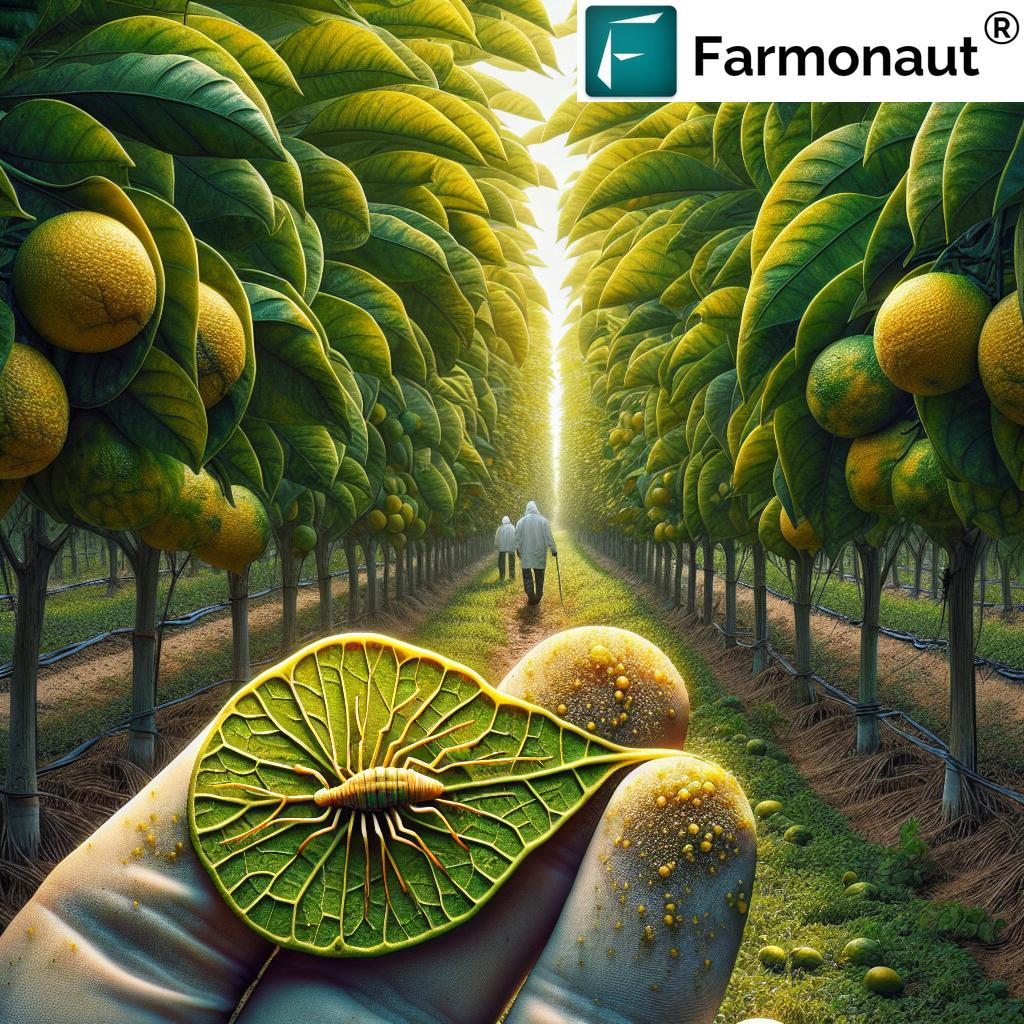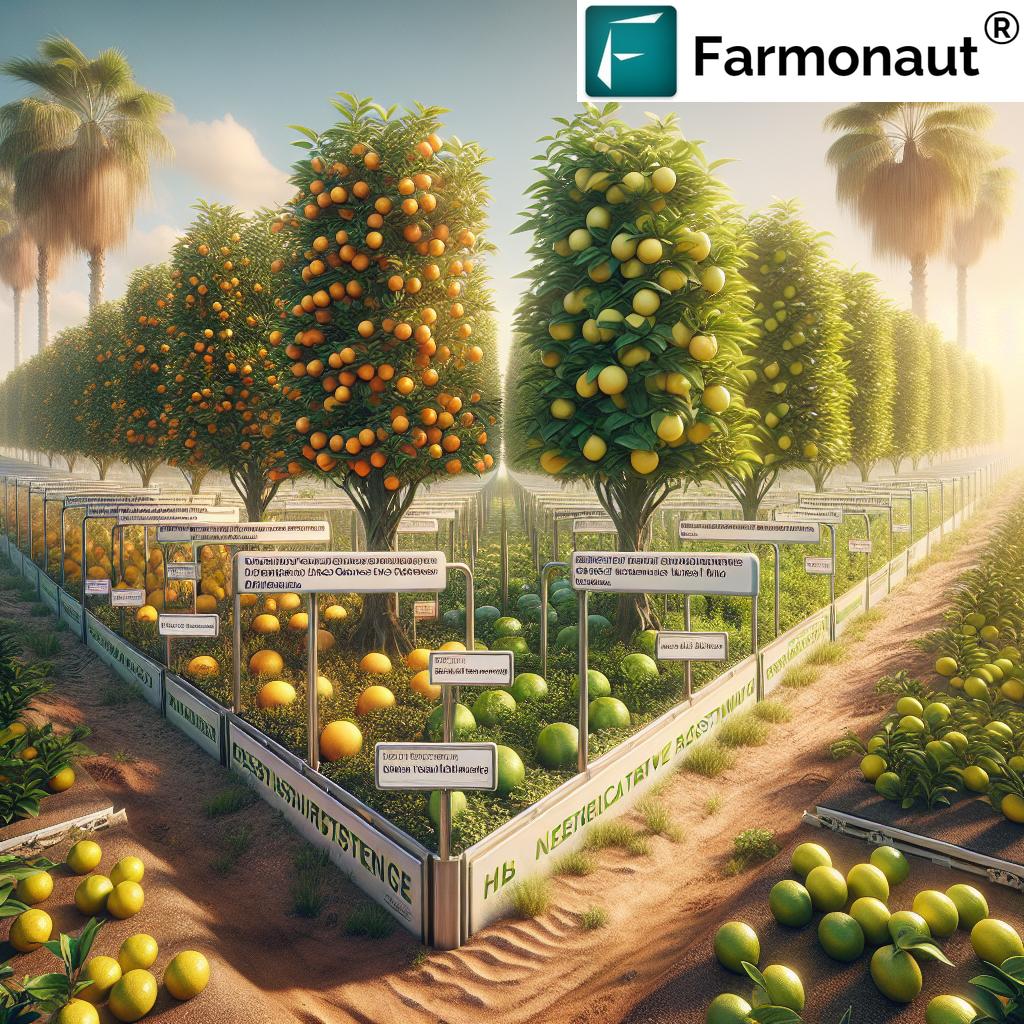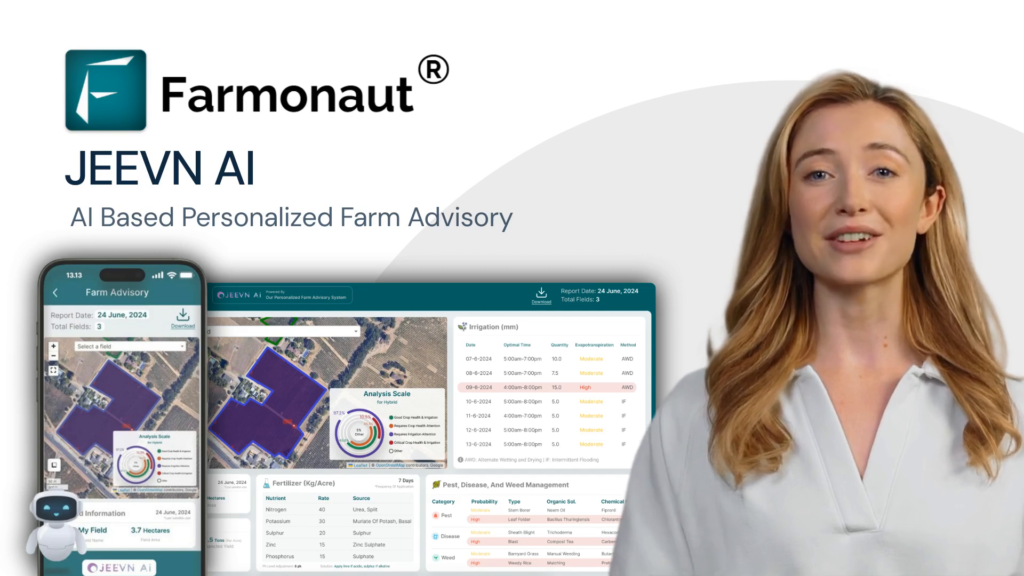Citrus Greening: 7 Shocking Fixes Florida Won’t Tell You
“Over 90% of Florida’s citrus groves are affected by citrus greening, slashing orange production by nearly 75% since 2005.”



Table of Contents
- Citrus Greening Disease: A Comprehensive Overview
- Etiology and Transmission: What Causes Citrus Greening?
- Huanglongbing Symptoms: How HLB Devastates Citrus Trees
- Impact of Citrus Greening on Production and Economy
- Citrus Disease Research: Florida’s Ongoing Quest
- Citrus Greening: 7 Shocking Fixes Florida Won’t Tell You
- Comparative Solutions Table for Citrus Greening
- Farmonaut: Leveraging Innovation for Citrus Disease Management
- Must-Watch Videos: Interpreting Satellite Data and Precision Agriculture
- FAQ: Citrus Greening, HLB, and Technology Solutions
- Conclusion: The Future of Citrus Cultivation
- Farmonaut Subscription Plans
Citrus Greening Disease: A Comprehensive Overview
Citrus greening disease, also called Huanglongbing (HLB), has emerged as the most devastating bacterial affliction threatening the global citrus industry. Characterized by rapid spread, insidious onset, and fatal impact on tree health, HLB is a challenge that no grower—particularly in Florida and other cornerstone citrus regions—can afford to ignore. The disease is responsible for a significant decline in citrus production, severe economic consequences, and even the collapse of family farms.
To manage this crisis, countries including the United States, Brazil, China, and India are investing in citrus disease research, resilient management strategies, and technological breakthroughs. As we analyze the etiology, huanglongbing symptoms, and explore 7 shocking fixes hiding just beneath the surface, our goal is to empower citrus growers, industry stakeholders, and agricultural innovators worldwide.
Etiology and Transmission: What Causes Citrus Greening?
The root of citrus greening lies in the bacteria belonging to the genus Liberibacter, with Liberibacter asiaticus as the most prevalent strain impacting global citrus production. The bacteria primarily spread through two insect vectors: the Asian citrus psyllid (Diaphorina citri) and the African citrus psyllid (Trioza erytreae). These tiny but highly effective psyllids feed on the phloem of infected trees, acquiring the bacterial pathogen, and rapidly inoculate healthy trees upon subsequent feeding. This vector-mediated transmission helps the disease disseminate swiftly across expansive citrus regions—from the groves of Florida to the plantations of Brazil and Asia.
Mechanism of Spread
- Feeding Behaviour: Psyllids insert their mouthparts into the vascular system, facilitating circulation of the bacteria.
- Vector Efficiency: Both adult and nymph stages can act as effective transmitters.
- Human-Mediated Spread: Movement of infected plant material, equipment, and even wind contributes to spread.
The disease’s insidious onset—where symptoms may surface years after initial infection—makes early detection and effective intervention particularly challenging for growers and agricultural authorities.
Huanglongbing Symptoms: How HLB Devastates Citrus Trees
HLB exerts its devastating impact on citrus trees through several hallmark symptoms, affecting nearly all aspects of tree growth, health, and fruit quality. Identifying these symptoms early is critical for integrated HLB management strategies in regions at risk.
1. Early Signs: Leaf and Vein Changes
- Yellowing of Leaf Veins and Tissues: Asymmetrical yellowing distinguishes HLB from common micronutrient deficiencies (these typically present symmetrically). The leaf tissue adjacent to veins takes on a blotchy, mottled appearance, making this a classic indicator of infection.
- Mottled & Thinned Foliage: Affected leaves look patchy or “sun-faded”, with thin, weakened tissues.
2. Fruit Disorders
- Small, Misshapen, and Green Fruits: Infected trees produce undersized fruits that often retain a green hue at the blossom end, failing to mature properly even as the season progresses.
- Bitter Taste and Thickened Peels: HLB-affected fruit is typically bitter—rendering it unmarketable—and features a thick, pale peel. The characteristics often extend to premature fruit drop.
3. Tree Decline and Death
- Stunted Growth: Ongoing infection leads to stunted new shoots, sparse canopies, and diminished fruiting.
- Twig Dieback and Tree Death: Progressive “dieback” of twigs and branches, eventually causing citrus tree health decline and death.
These stubborn symptoms collectively result in rapid, catastrophic losses in fruit yield and quality, as seen in the groves of Florida and beyond.
“Researchers have identified more than 7 innovative management strategies to combat HLB, including gene editing and advanced nutrient therapies.”
Impact of Citrus Greening on Production and Economy
The impact of citrus greening on production and the economy—especially in Florida—has been nothing short of catastrophic. Since the first identification of HLB in Florida in 2005, the state has seen a 75% decline in citrus production within just two decades. The consequences extend beyond reduced harvests to reshape the global citrus sector.
Citrus Greening Economic Impact: Key Facts
- Declining Gross Revenue: Florida’s citrus industry value has nosedived—from $9 billion to around $2 billion per year.
- Ripple Effects: Processing plants, distribution networks, retail chains, and thousands of workers face economic insecurity due to shrinking crop yields.
- Rising Costs: Growers must invest in costly management efforts, robust vector control, and novel treatments just to remain viable.
- Fragmented Groves: Growers are forced to remove infected trees, sometimes entire blocks, in an effort to manage HLB spread.
Global Distribution and Spread
HLB’s devastating impact isn’t limited to Florida. The disease is reported in all major citrus-producing regions of the United States—including California and Texas—and has reached the large-scale plantations of China, India, and Brazil. Countries where citrus cultivation is a cornerstone of the agricultural sector are particularly vulnerable.
Given these consequences, a comprehensive approach—integrating HLB management strategies with cutting-edge technology and community action—is more crucial than ever.
Citrus Disease Research: Florida’s Ongoing Quest
No single outbreak in recent agricultural history has mobilized research funding and scientific innovation quite like citrus greening. The United States Department of Agriculture (USDA), National Institute of Food and Agriculture (NIFA), and leading universities have dedicated over $30 million to citrus disease research and HLB management strategies in recent years.
Key Research Initiatives
-
Genetic Research for Resistance:
- Development of GMOs and naturally HLB-resistant citrus varieties (see our section below for innovative progress).
-
Novel Antimicrobial Treatments:
- Use of targeted antibiotic treatments (e.g., streptomycin, oxytetracycline) with tight regulatory oversight.
-
Next-Gen Vector Management:
- Biological control agents, advanced chemical sprays, and alternative matrices targeting the Asian citrus psyllid.
-
Technology-Driven Monitoring:
- Incorporation of satellite imagery, drones, and AI-based disease detection to identify infected trees and optimize management.
Despite these efforts, HLB’s rapid evolution and adaptability demand constant vigilance, robust funding, and—crucially—innovative thinking. Let’s reveal the game-changing fixes Florida won’t tell you!
Citrus Greening: 7 Shocking Fixes Florida Won’t Tell You
The path to managing citrus greening disease is anything but routine. Across the globe, researchers and progressive growers are piloting truly innovative—and sometimes controversial—strategies that promise to rewrite the rules of citrus survival. Here are the 7 most surprising and shocking fixes that industry insiders are closely watching:
-
Gene Editing for HLB Resistant Citrus Varieties
CRISPR and similar gene-editing tools are being used to develop trees that demonstrate genuine, heritable resistance to Liberibacter asiaticus. Unlike traditional breeding, breakthrough edits involving antimicrobial proteins from spinach or other species may offer resistance without GMO regulatory obstacles. These “designer” citrus trees could halt the impact of HLB on production within a decade—if fully accepted.
-
Heat Treatment for Tree Disinfection
Controlled “thermal therapy”—where infected trees are briefly exposed to high temperatures—can kill the Liberibacter bacteria in phloem without lethal damage to trees. Although the logistics for field-scale use are challenging, portable units are being trialed in Florida.
-
Biological Psyllid Control with Wolbachia and Parasitoids
Instead of relying only on chemical insecticides, researchers are releasing parasitoid wasps and exploring Wolbachia bacterial infections within psyllids. These natural and symbiotic agents reduce vector capacity—delaying or halting HLB spread.
-
Advanced Nutritional Therapies and Fortified Fertilization
Comprehensive research shows that adjustment of micronutrient ratios (especially zinc, manganese, and magnesium) and intensified fertilization can temporarily boost infected tree vigor and delay decline—even though this does not eliminate the bacteria. Farm management platforms like Farmonaut’s Large-Scale Farm Management App help schedule and monitor precision fertilization for optimal results and sustainable resource utilization.
-
Systemic Antibiotic Trunk Injection
Targeted trunk injection with antibiotics (oxytetracycline, streptomycin) has regulatory approval in some states. This approach delivers bacteria-killing agents directly into the tree’s vascular system—offering temporary relief but also raising concerns over environmental impact, resistance, and consumer acceptance. Note: This fix should be used judiciously, in concert with strict regulations.
Explore NIFA’s $11M investment into citrus greening antibiotic research
-
Early Detection and Precision Removal with Satellite-Based Monitoring
Technologies such as Farmonaut’s Satellite Crop Monitoring make it possible to detect subtle changes in vegetation health due to incipient HLB infection—even before visual symptoms appear. Early identification allows surgical removal of infected trees, preventing wide-scale spread and reducing unnecessary loss. Learn about our API (Farmonaut API) for integrating satellite and weather data into custom solutions, or see our API developer docs (API Docs).
-
Blockchain-Based Disease Traceability & Supply Verification
Farmonaut’s blockchain traceability platform secures data on disease status at every stage—allowing industry and consumers to track the integrity of fruit from grove to supermarket. This fosters greater transparency, prevents fraudulent sales from unregulated or infected regions, and increases market confidence.
These disruptive solutions—most of which are not widely publicized in “traditional” Florida citrus circles—highlight the wave of innovation required to secure our agricultural future.
Comparative Solutions Table for Citrus Greening
To help growers, researchers, and agribusinesses evaluate their options, here’s a side-by-side overview comparing conventional and technology-driven HLB management strategies.
| Solution/Strategy | Description | Estimated Effectiveness (%) | Implementation Cost (USD, est.) | Adoption Rate (Florida, est.) | Notable Technologies Used |
|---|---|---|---|---|---|
| Chemical Sprays | Use of insecticides to control Asian/African citrus psyllid vectors and slow HLB spread. | 45–60 | $450–$750/ha/year | Very High (80%+) | Pesticide delivery, aerial application |
| Biological Control Agents | Releasing predatory insects (e.g., parasitoid wasps) or deploying Wolbachia bacteria to reduce psyllid populations. | 30–50 | $200–$400/ha/year | Moderate | Biological agents, laboratory rearing |
| Heat Treatment | High-temperature field or greenhouse treatments to kill Liberibacter bacteria in trees. | 35–55 | $1000+/tree (specialized equipment) | Very Low | Mobile heat units, sensors |
| Genetic Modification | Gene editing (e.g., CRISPR) or conventional breeding to produce HLB-resistant citrus cultivars. | 80–90* | $10,000+ (R&D/propagation); $15+/tree | Low (emerging) | CRISPR, genetic markers, tissue culture |
| Monitoring with Drones/Satellites | Early detection of infection and precision tree removal via high-resolution satellite or drone data platforms. | 60–75 | $3–$10/ha/month | Low to Moderate | Satellite imagery, machine learning, NDVI |
| Precision Fertilization | Data-driven nutrient management to improve tree resistance and delay decline. | 35–45 | $200–$350/ha/year | Moderate | Soil testing, AI scheduling, nutrient mapping |
| Resistant Rootstock Development | Breeding/selecting rootstocks that impede HLB bacterial movement in trees. | 60–80 | $10–$20/tree (nursery production) | Low (pilot scale) | Genomics, hybridization |
*Effectiveness of genetic solutions can approach 90% for certain transgenic lines but varies by tree age and grove conditions.
Farmonaut: Leveraging Innovation for Citrus Disease Management
At Farmonaut, we’re passionate about using cutting-edge technology to make precision agriculture accessible, scalable, and affordable for citrus growers worldwide. While citrus greening continues to pose severe challenges, our suite of technology-driven tools offers critical support in detection, management, and sustainability.
How Farmonaut Empowers HLB Management
- Satellite-Based Crop Health Monitoring: Leveraging multispectral imagery, our system detects subtle changes in vegetation health—pinpointing “hot spots” of infection and enabling early, targeted removal or intervention. This reduces unnecessary tree loss and halts rapid spread.
- AI-Powered Jeevn Advisory: Receive automated, crop-specific recommendations on nutrient management, irrigation, pest, and psyllid control in citrus. These insights are continuously refined using real-time data for maximum effectiveness against disease pressure.
- Blockchain Product Traceability: Transparent, blockchain-based tracking secures every stage from grove to retail. This protects brand reputation, consumer safety, and market access in disease-affected regions. Explore traceability options.
- Resource Management & Carbon Footprinting: Our carbon footprinting tool records emissions and sustainability compliance, vital for eco-sensitive citrus production.
- Fleet and Large-Scale Farm Management: With Farmonaut’s farm management platform, growers can coordinate operations, monitor inputs, and boost compliance at scale—even across diverse groves and teams.
- API and Developer Integration: Build custom solutions, integrate satellite data into lab results, and automate citrus greening treatment options using our robust Farmonaut API and developer resources.
By integrating innovation, data, and smart practices, we offer a route forward beyond the limitations of conventional “spray and pray” approaches. This is the future of sustainable disease management in agriculture.
Must-Watch Videos: Interpreting Satellite Data and Precision Agriculture
For those eager to bolster their disease management arsenal with remote sensing, AI, and actionable insights, here are a few highly recommended, in-depth video tutorials. Learn how Farmonaut puts technology and innovation in your hands for better decision-making in disease-affected citrus groves:
FAQ: Citrus Greening, HLB, and Technology Solutions
What is citrus greening disease, and why is it so threatening?
Citrus greening disease (HLB) is a bacterial affliction caused by Liberibacter species, primarily L. asiaticus. It’s transmitted by psyllid insects. HLB undermines tree health, causing fruit that is small, misshapen, and bitter, and ultimately leads to tree death—resulting in severe yield reduction and economic loss.
How do you identify huanglongbing symptoms in a citrus orchard?
- Asymmetrical leaf yellowing (especially on veins and adjacent tissues).
- Mottled and pale foliage, often confused with nutrient deficiencies but spotty/asymmetric.
- Green, small, or misshapen fruit with thick rinds and bitter taste.
- Declining tree vigor, twig dieback, and premature fruit drop.
What makes HLB management strategies effective?
Layering multiple strategies (vector control, resistant varieties, early detection, precision nutrition, and technology-driven monitoring) provides the best chance for success. Conventional approaches alone (e.g., chemical sprays) are no longer sufficient.
How does technology, including Farmonaut, help manage citrus greening?
Farmonaut leverages satellite monitoring, AI-driven recommendations, and blockchain traceability to enable early detection, optimize nutrition and chemical use, and provide transparency at every stage. This empowers timely, data-driven interventions no matter the size of the farm.
Is there a cure for citrus greening disease?
There is no absolute cure, especially for mature trees. However, resistant varieties, advanced heat/antibiotic therapy, biological vector controls, and gene-editing breakthroughs are helping reduce new infections and prolong orchard life.
How can growers access Farmonaut’s platform?
Our solutions are available via web app, Android app, iOS app, and direct API/API docs. Our team is committed to empowering growers with real-time data-driven insights globally.
What are the current regulatory concerns with antibiotics and gene-edited citrus?
While antibiotic trunk injections can provide temporary relief, overuse raises concerns about environmental impact, residues, and resistance. Gene-edited citrus varieties are largely in the research or pilot stages, with regulatory acceptance varying by country and region.
How do blockchain and traceability help fight citrus diseases?
By securing and verifying the disease status, provenance, and handling of each product, blockchain-based traceability reduces fraud, increases market trust, and prevents disease-contaminated products from entering the supply chain. Farmonaut’s traceability solution addresses these key needs for citrus growers and corporate clients.
Conclusion: The Future of Citrus Cultivation
Citrus greening (HLB) stands as one of the most formidable challenges facing agriculture today—not only in Florida but across all citrus-producing countries. Its rapid spread, devastating impact, and complex bacterial etiology call for a shift in thinking: from reliance on chemical controls to a broad spectrum of innovative, sustainable, and technology-driven solutions.
With continued investment in research, the development of HLB-resistant citrus varieties, targeted antibiotic and heat therapies, advanced vector management, and—most crucially—technological innovation, there is hope for stabilizing and reviving citrus production. Platforms like Farmonaut are democratizing powerful disease management tools, making them accessible to growers and agribusinesses of every scale, and helping to build a more resilient, transparent, and productive future for the global citrus industry.
Together, leveraging science, data, and best practices, we can safeguard the citrus groves of Florida and the world from the ongoing threat of citrus greening.
Farmonaut Subscription Plans
Access cost-effective, scalable, and robust technology solutions for citrus disease management and precision agriculture worldwide:
















Pretty! This has been a really wonderful post. Many thanks for providing these details.